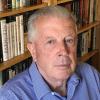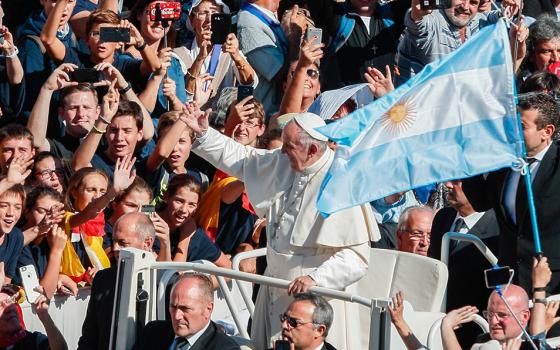 Catholic scholars and political activists Ed Gaffney, Douglas W. Kmiec and Patrick Whelan wrote America Undecided: Why Obama Deserves a Second Term as a final attempt to persuade wavering Catholics that President Obama is our best hope to address a Catholic social agenda in the next four years. One has to wonder why it came so late in the election cycle — the publishing date was Oct. 21 — but it will stand as an historical document to help us understand what the 2012 election was about. And it may give some future guidance to Catholics interested in melding politics with their faith.
Catholic scholars and political activists Ed Gaffney, Douglas W. Kmiec and Patrick Whelan wrote America Undecided: Why Obama Deserves a Second Term as a final attempt to persuade wavering Catholics that President Obama is our best hope to address a Catholic social agenda in the next four years. One has to wonder why it came so late in the election cycle — the publishing date was Oct. 21 — but it will stand as an historical document to help us understand what the 2012 election was about. And it may give some future guidance to Catholics interested in melding politics with their faith.
Gaffney is professor of law at Valparaiso University, concentrating on religious freedom and a course on war and peace. Kmiec, retired U.S. ambassador, is the Caruso Family Chair and Professor of Constitutional Law & Human Rights at Pepperdine University. Whelan is on the pediatrics faculty at Harvard Medical School and is a pediatric rheumatology specialist at the Massachusetts General Hospital for Children in Boston. He is also Clinical Assistant Professor at the Keck School of Medicine of the University of Southern California. He also serves on NCR’s board of directors.
It is available in paperback and as an ebook.
The first part of America Undecided addresses the phenomenon of the undecided voter, the background and values of Barak Obama, the differences between 2008 and 2012, and presents a summary of Catholic social teaching.
But the major contribution of this timely book is to present a balanced, thorough and readable treatment of the Affordable Care Act, the President’s philosophy in committing to this major, politically risky endeavor, the abortion policy issues involved, the HHS contraception mandate, and the religious liberty controversy. America Undecided covers the role of the U S Bishops in both the legislative and regulatory battles, the roles of the Catholic Health Association and the Leadership Conference of Religious Women, the upholding of the ACA by the Supreme Court, and the hyperbolic and distortive rhetoric that so often clouds the real issues around health care and religious liberty, impedes the appropriate application of Catholic social teaching and challenges the capacity of thoughtful Catholics to make informed, conscience driven public policy and electoral decisions.
The book points out how a Romney-Ryan ticket offers no pro life guarantees and that the Romney-Ryan budget plan will devastate Medicaid. We are reminded that not only did Obama win the overall Catholic vote in 2008, but that he won in Ohio, Pennsylvania, Michigan and Indiana in spite of the opposition of a number of Catholic bishops. We learn of the history of the individual mandate, and the New England Journal of Medicine study by co-author Dr. John Whelan showing that abortion declined after the implementation of the Romney health care law in Massachusetts.
America Undecided covers the Stupak amendment attempting to clarify the prohibition on abortion funding in the House version of ACA, as well as the executive order signed by the President affirming that there would be no abortion funding in the law. The authors make it clear that nothing in ACA expands abortion rights or provides funding for abortion, and they maintain that this healthcare reform effort will decrease abortions by addressing the conditions that cause a great number of abortions. They remind us that poverty is the most significant abortifacient. They also make the case that abortion reduction efforts are a far more pro life stance than the never ending futile effort to outlaw abortion.
The book points out that the Catholic bishops were unwilling to compromise or even acknowledge Democratic efforts to respond to their concerns. As a result of their rigidity, they lost badly in the political arena, came across as opposing universal health care in spite of the rich history of Church advocacy for this cause, and adding insult to injury, they lost out to the Catholic Health Association and the LCWR who stuck to the principles of Catholic social teaching but knew how to forge a constructive compromise. The same result occurred during the HHS contraception mandate battle, when responding to Catholic concerns, the administration amended the mandate, which was good enough for CHA but not for the bishops. The authors also contradict those bishops who insisted that the HHS mandate was a new, unprecedented violation of religious liberty, pointing out that it was in fact based on an earlier California statute and subsequent laws in twenty other states that most bishops never challenged.
The authors make a valuable contribution in distinguishing between RU86, an abortifacient not on the HHS contraception mandate list, and drugs such as Plan B and Ella which are pregnancy preventers. In doing so they attempt to offset those bishops and their spokespersons who either out of confusion or deliberately, continue to wrongly state that the mandate includes abortifacients. Hopefully this will blunt the over the top rantings of some of our bishops that Obama is pro abortion and is making war on the Church.
In the last section of the book there is a comprehensive and informative treatment of the distinction between abortion and contraception, highlighting the work of Judge John Noonan and other Catholic commentators and scholars. There is also a thoughtful reflection on religious freedom, as well as a reference to the unresolved issue of the conscience rights of Catholic employers who are self insured.
America Undecided concludes with a look at the nastiness of the political arena, a review of the concepts of solidarity and subsidiarity, a call for a more just economy, and of course, a strong pitch for the re-election of President Obama.
[Brian Cahill is the former executive director of San Francisco Catholic Charities. Dennis Coday is NCR editor.]


